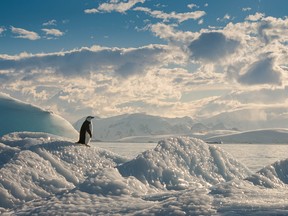Temperatures in March are usually round -54C on the east coast close to the Dome C. On March 18, 2022, temperatures peaked to -10C

In March 2022, temperatures close to the jap coast of Antarctica spiked 70 levels Fahrenheit (39 levels Celsius) above regular – making it probably the most intense recorded warmth wave to happen anyplace on Earth, in keeping with a latest research. On the time, researchers on-site have been carrying shorts and a few even eliminated their shirts to bask within the (relative) heat. Scientists elsewhere stated such a excessive in that area of the world was unthinkable.
“It was simply very obvious that it was a exceptional occasion,” stated Edward Blanchard-Wrigglesworth, writer of the research. “We discovered that temperature anomaly, the 39-degree temperature anomaly, that’s the most important anyplace ever measured anyplace on the earth.”
Temperatures in March, marking a develop into autumn on the continent, are usually round minus-54 levels Celsius on the east coast close to the Dome C. On March 18, 2022, temperatures peaked to minus-10 levels Celsius. That’s hotter than even the most popular temperature recorded in the course of the summer season months in that area – “that in itself is fairly unbelievable,” stated Blanchard-Wrigglesworth, an atmospheric scientist on the College of Washington.
Within the new analysis, Blanchard-Wrigglesworth and his colleagues investigated how and why such an unimaginable warmth wave might have occurred, particularly at a time of the 12 months when there may be much less daylight. They discovered the intense warmth is essentially a part of Antarctica’s pure variability, although the warming local weather did have some impact.
The seeds for the warmth wave, Blanchard-Wrigglesworth stated, started with uncommon winds. Usually, winds blow from west to east round Antarctica and assist isolate the continent from hotter areas farther north, permitting it to remain chilly. However simply as happens with warmth waves in the USA, the winds meandered and allowed a heat mass of air from southern Australia to maneuver to East Antarctica in simply 4 days – “in all probability the primary time that a minimum of it’s occurred that quick,” Blanchard-Wrigglesworth stated.
The northerly winds additionally introduced a number of moisture, bringing important snow, rain and melting on the jap coast of the ice sheet.
On the similar time, Antarctica was experiencing its lowest sea ice on file, although the group stated their work means that didn’t seem to affect the warmth wave.
Large swings in climate aren’t utterly out of the odd within the polar areas, the research discovered. In an evaluation of world climate station information and pc simulations, the group discovered the most important temperature modifications from regular happen at excessive latitudes. Locations like Europe or the USA’ Decrease 48 by no means expertise such anomalous warmth waves.
There’s a fundamental cause the most important anomalies occur at these excessive latitudes, Blanchard-Wrigglesworth stated – there’s extra chilly air to take away close to the bottom. Usually, air turns into colder larger within the ambiance. However some locations – like at excessive latitudes with a number of snow and ice – have colder air close to the bottom and hotter air above it, referred to as an inversion layer. In these spots, a heat air mass can swoop in to displace the chilly air and create heat climate. These heat occasions usually occur throughout or round winter, when the inversion layers are the strongest.
“That’s what we noticed for the Antarctic warmth wave,” Blanchard-Wrigglesworth stated. “These occasions form of erode that inversion, you do away with it.”
Meteorologist Jonathan Wille, who was not concerned within the research, stated he’s not shocked that this Antarctic warmth wave registered as the most important noticed temperature anomaly anyplace. In spite of everything, the Antarctic Plateau has among the highest temperature variability on the earth.
The entire function of local weather change remains to be underneath investigation, though the brand new research asserts that the hotter ambiance didn’t play a big function boosting temperatures. The group ran a collection of pc fashions working eventualities that included elevated greenhouse gasoline emissions vs. a world that didn’t. They discovered local weather change solely elevated the warmth wave by 2 levels Celsius. By the top of the century, local weather change might enhance such a warmth wave by an extra 5 to six levels Celsius.
“A 2C enhance for a heatwave that was 39C above common signifies that this warmth wave would have been file shattering with out the local weather change sign,” Wille, a researcher at ETH Zurich, wrote in an e-mail.
However local weather change might have had one other impact the fashions didn’t check, such because the impact on the anomalous winds that introduced the nice and cozy air mass to the continent within the first place. Wille stated uncommon tropical downpours within the weeks beforehand created an atmospheric circulation sample that was by no means noticed earlier than – resulting in the intense warmth.
“It’s doable that local weather change influenced the atmospheric dynamics just like the tropical convection anomalies that led to the warmth wave, however that is very troublesome to quantify these items,” Wille stated.
Blanchard-Wrigglesworth stated extra warmth waves like this in Antarctica in a hotter world might have dire results on the ice sheet.
“When you add one other 5 or 6 levels on high of that, you’re beginning to get near the melting level,” Blanchard-Wrigglesworth stated. If these occasions have been to change into extra widespread in 50 and even 100 years, “this type of occasion may set off some impacts that perhaps we didn’t have on our radar.”